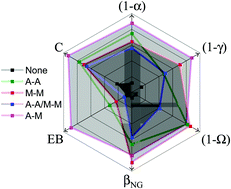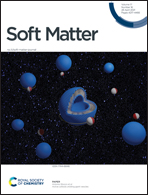Subtle changes in crosslinking drive diverse anomalous transport characteristics in actin–microtubule networks†
Abstract
Anomalous diffusion in crowded and complex environments is widely studied due to its importance in intracellular transport, fluid rheology and materials engineering. Specifically, diffusion through the cytoskeleton, a network comprised of semiflexible actin filaments and rigid microtubules that interact both sterically and via crosslinking, plays a principal role in viral infection, vesicle transport and targeted drug delivery. Here, we elucidate the impact of crosslinking on particle diffusion in composites of actin and microtubules with actin–actin, microtubule–microtubule and actin–microtubule crosslinking. We analyze a suite of transport metrics by coupling single-particle tracking and differential dynamic microscopy. Using these complementary techniques, we find that particles display non-Gaussian and non-ergodic subdiffusion that is markedly enhanced by cytoskeletal crosslinking, which we attribute to suppressed microtubule mobility. However, the extent to which transport deviates from normal Brownian diffusion depends strongly on the crosslinking motif – with actin–microtubule crosslinking inducing the most pronounced anomalous characteristics. Our results reveal that subtle changes to actin–microtubule interactions can have complex impacts on particle diffusion in cytoskeleton composites, and suggest that a combination of reduced filament mobility and more variance in actin mobilities leads to more strongly anomalous particle transport.



 Please wait while we load your content...
Please wait while we load your content...